Integrated Water Resources Management in a Lake System: A Case Study in Central Italy
Abstract
:1. Introduction
2. Materials and Methods
2.1. SimBaT Decision Support System
- (1)
- The first section covers the input of digital data (reservoir, flows, demands, minimum instream flow), as time series or typical year, together with the river network topology information. These operations are made easy by user-friendly interfaces, which during the construction of the network automatically store the topological features according to a hierarchical structure of nodes-arcs.
- (2)
- The second section is the core of the model with the calculation algorithm, which performs a water balance between availability and demand all over the basin, where the environmental water use has, in any case, a strict priority and it is reserved before calculating the Total Available Volume (TAV) and it is monitored in the control node. According to the concept of ecological flow or environmental flow, SimBaT supports the simulation of ecological discharges which can be artificially maintained by reservoir management. The algorithm for water management applied under deficit conditions uses a “balanced priority”, according to a principle of sustainability and sharing of expected deficits. The balances are calculated on a projection of some time steps in advance, t = (i; i + k). Therefore the decision whether or not to manage and thus to reduce the distribution of water (αrid), depends on the values taken on by the ratio between the Total Requirement Volume (TRV) and the Total Available Volume in the reservoir (S).When in fact this ratio (1) assumes a value less than 1, it is necessary to reduce the releases for the users (FAj), thus defining a management scenario in which the Available Volume (AV) in the simulation period i is a function of the value αrid as follows,The problem of managing reservoir releases during periods of deficit can be studied in terms of optimization between the various uses, or in terms of the simulation of hypothetical scenarios. Partly, in this model, an attempt was made to interpret the logic of optimization, which, however, is difficult to apply in the presence of environmental forcing, and when economic values, which are difficult to quantify, are taken into account. Therefore we tried to make the management phase of the model more flexible, in order to develop a tool that can be adapted to the needs of various political and economic constraints and in different territorial scenarios. Therefore, a management procedure called “balanced priority” was studied. The term “priority” means that priorities must be set among the various users served, as foreseen in the national legislation, while the term “balanced” means that the system deviates from the strict logic of distributing the resource first to uses with higher priority and then to those with a lower priority, or by serving the economically advantageous uses first. In “balanced priority” the water released is reduced by a certain percentage, which varies from use to use, starting from the last in order of priority, each time repeating the budget until αrid > 1 [37]. This procedure essentially allows the deficit between the various types of uses to be distributed, according to different levels of tolerance that can be decided and commonly agreed upon among the various stakeholders.
- (3)
- The third section concerns the data output. Reading of the output data is extremely flexible both in graphic and numerical terms, with particular attention to the possible use of the model when short-term probabilistic assessments are concerned.
2.2. Water Balance of Lake Trasimeno
3. Results and Discussion
3.1. SimBaT Simulation
3.1.1. Simulation Scenario n.1
3.1.2. Simulation Scenario n.2
3.2. Lake Trasimeno Levels
3.2.1. Climate Change and the Effects on Lake Trasimeno Levels
4. Conclusions
Acknowledgments
Author Contributions
Conflicts of Interest
References
- Deffenu, L.; Dragoni, W. Idrogeologia del lago Trasimeno. Geol. Appl. Idrogeol. 1978, 13, 11–67. (In Italian) [Google Scholar]
- Pezzutto, D. Leonardo’s Val di Chiana Map in the Mona Lisa. Cartographica 2011, 46, 149–159. [Google Scholar] [CrossRef]
- Ludovisi, A.; Gaino, E.; Bellezza, M.; Casadei, S. Impact of climate change on the hydrology of shallow Lake Trasimeno (Umbria, Italy): History, forecasting and management. Aquat. Ecosyst. Health Manag. 2013, 16, 190–197. [Google Scholar]
- Ludovisi, A.; Gaino, E. Meteorological and water quality changes in Lake Trasimeno (Umbria, Italy) during the last fifty years. J. Limnol. 2010, 69, 174–188. [Google Scholar] [CrossRef]
- Ubertini, L.; Manciola, P.; Casadei, S. Evaluation of the minimum instream flow of the Tiber River Basin. Environ. Monit. Assess. 1996, 41, 125–136. [Google Scholar] [CrossRef] [PubMed]
- Pierleoni, A.; Bellezza, M.; Casadei, S.; Manciola, P. Multipurpose water use in a system of reservoirs. In Changes in Water Resources Systems: Methodologies to Maintain Water Security and Ensure Integrated Management; International Association of Hydrological Sciences: Wallingford, UK, 2007; Volume 315, pp. 107–116. [Google Scholar]
- Huang, Y.; Solomatine, D.P.; Velickov, S.; Abbott, M.B. Distributed environmental impact assessment using Internet. J. Hydroinform. 1999, 1, 59–70. [Google Scholar]
- Sanches Fernandes, L.F.; Santos, C.M.M.; Pereira, A.P.; Moura, J.P. Model of management and decision support systems in the distribution of water for consumption—Case study in North Portugal. Eur. J. Environ. Civ. Eng. 2011, 15, 411–426. [Google Scholar]
- Stefanovic, N.; Radojevic, I.; Ostojic, A.; Comic, L.; Topuzovic, M. Composite Web Information System for Management of Water Resources. Water Resour. Manag. 2015, 29, 2285–2301. [Google Scholar] [CrossRef]
- Zhang, D.; Chen, X.; Yao, H. Development of a Prototype Web-Based Decision Support System for Watershed Management. Water 2015, 7, 780–793. [Google Scholar] [CrossRef]
- Sridhar, P.S.; Jowhar, T.N.; Garg, A.B.; Kedareswarudu, U. A Framework of Information Technology for Water Resources Management. Int. J. Comput. Appl. 2011, 30, 21–25. [Google Scholar] [CrossRef]
- Fedra, K.; Harmancioglu, N.B. A web-based water resources simulation and optimization system. In CCWI 2005 on Water Management for the 21st Century; Savic, D., Walters, G., King, R., Khu, A.T., Eds.; Center of Water Systems, University of Exeter: Exeter, UK, 2005; Volume II, pp. 167–172. [Google Scholar]
- Li, C.; Zhou, J.; Ouyang, S.; Wang, C.; Liu, Y. Water Resources Optimal Allocation Based on Large-scale Reservoirs in the Upper Reaches of Yangtze River. Water Resour. Manag. 2015, 29, 2171–2187. [Google Scholar] [CrossRef]
- Ahmad, A.; El-Shafie, A.; Razali, S.F.M.; Mohamad, Z.S. Reservoir Optimization in Water Resources: A Review. Water Resour. Manag. 2014, 28, 3391–3405. [Google Scholar] [CrossRef]
- Afshar, A.; Shafii, M.; Haddad, O.B. Optimizing multi-reservoir operation rules: An improved HBMO approach. J. Hydroinform. 2011, 13, 121–139. [Google Scholar] [CrossRef]
- Yang, J.; Li, G.; Wang, L.; Zhou, J. An Integrated Model for Simulating Water Resources Management at Regional Scale. Water Resour. Manag. 2015, 29, 1607–1622. [Google Scholar] [CrossRef]
- Matrosov, E.S.; Harou, J.J.; Loucks, D.P. A computationally efficient open-source water resource system simulator—Application to London and the Thames Basin. Environ. Model. Softw. 2011, 26, 1599–1610. [Google Scholar] [CrossRef]
- Kakahaji, H.; Banadaki, H.D.; Kakahaji, A.; Kakahaji, A. Prediction of Urmia Lake Water-Level Fluctuations by Using Analytical, Linear Statistic and Intelligent Methods. Water Resour. Manag. 2013, 27, 4469–4492. [Google Scholar] [CrossRef]
- Manos, B.; Bournaris, T.; Silleos, N.; Antonopoulos, V.; Papathanasiou, J. A decision support system approach for rivers monitoring and sustainable management. Environ. Monit. Assess. 2004, 96, 85–98. [Google Scholar] [CrossRef] [PubMed]
- Manos, B.; Papathanasiou, J.; Bournaris, T.; Voudouris, K. A DSS for Sustainable Development and Environmental Protection of Agricultural Regions. Environ. Monit. Assess. 2010, 164, 43–52. [Google Scholar] [CrossRef] [PubMed]
- Manos, B.; Ciani, A.; Bournaris, T.; Vassiliadou, I.; Papathanasiou, J. A taxonomy survey of decision support systems in agriculture. Agric. Econ. Rev. 2004, 5, 80–94. [Google Scholar]
- Sanches Fernandes, L.F.; Marques, M.J.; Oliveira, P.C.; Moura, J. Decision Support Systems in Water Resources in the Demarcated Region of Douro—Case study in Pinhão River Basin, Portugal. Water Environ. J. 2014, 28, 350–357. [Google Scholar] [CrossRef]
- Sanches Fernandes, L.F.; Seixas, F.; Oliveira, P.C.; Leitao, S.; Moura, J. Climate-Change impacts on nitrogen in a hydrographical basin in the northeast of Portugal. Fresenius Environ. Bull. 2012, 21, 3643–3650. [Google Scholar]
- Niswonger, R.G.; Allander, K.K.; Jeton, A.E. Collaborative modelling and integrated decision support system analysis of a developed terminal lake basin. J. Hydrol. 2014, 517, 521–537. [Google Scholar] [CrossRef]
- Altunkaynak, A. Predicting Water Level Fluctuations in Lake Michigan-Huron Using Wavelet-Expert System Methods. Water Resour. Manag. 2014, 28, 2293–2314. [Google Scholar] [CrossRef]
- Altunkaynak, A. Forecasting surface water level fluctuations of Lake Van by artificial neural networks. Water Resour. Manag. 2017, 21, 339–408. [Google Scholar] [CrossRef]
- Sewagudde, S. Lake Victoria’s Water Budget and the Potential Effects of Climate Change in the 21st Century. Afr. J. Trop. Hydrobiol. Fish. 2009, 12, 22–30. [Google Scholar] [CrossRef]
- Di Francesco, S.; Biscarini, C.; Montesarchio, V.; Manciola, P. On the role of hydrological processes on the water balance of Lake Bolsena, Italy. Lakes Reserv. Res. Manag. 2016, 21, 45–55. [Google Scholar] [CrossRef]
- Ma, J.; Hipel, K.W.; De, M. Devils lake emergency outlet diversion conflict. J. Environ. Manag. 2011, 92, 437–447. [Google Scholar] [CrossRef] [PubMed]
- Grigg, N.S. Integrated water resources management: Balancing views and improving practice. Water Int. 2008, 33, 279–292. [Google Scholar] [CrossRef]
- Rossi, G.; Castiglione, L.; Bonaccorso, B. Guidelines for planning and implementing drought mitigation measures. In Methods and Tools for Drought Analysis and Management; Rossi, G., Vega, T., Bonaccorso, B., Eds.; Water Science and Technology Library; Springer: Dordrecht, The Netherlands, 2007; Volume 62, pp. 325–347. [Google Scholar]
- O’Reilly, C.M.; Sharma, S.; Gray, D.K.; Hampton, S.E.; Read, J.S.; Rowley, R.J.; Schneider, P.; Lenters, J.D.; McIntyre, P.B.; Kraemer, B.M.; et al. Rapid and highly variable warming of lake surface waters around the globe. Geophys. Res. Lett. 2015, 42. [Google Scholar] [CrossRef]
- Arnell, N.W.; Delaney, E.K. Adapting to climate change: Public water supply in England and Wales. Clim. Chang. 2006, 78, 227–255. [Google Scholar] [CrossRef]
- Steidl, J.; Schuler, J.; Schubert, U.; Dietrich, O.; Zander, P. Expansion of an Existing Water Management Model for the Analysis of Opportunities and Impacts of Agricultural Irrigation under Climate Change Conditions. Water 2015, 7, 6351–6377. [Google Scholar] [CrossRef]
- Simonovic, S.P. Tools for water management—One view of the future. Water Int. 2000, 25, 76–88. [Google Scholar] [CrossRef]
- Georgiou, P.E.; Papamichail, D.M.; Vougioukas, S.G. Optimal irrigation reservoir operation and simultaneous multi-crop cultivation area selection using simulated annealing. Irrig. Drain. 2006, 55, 29–144. [Google Scholar] [CrossRef]
- Bellezza, M.; Casadei, S.; Manciola, P.; Pierleoni, A. Mathematical model for multipurpose water resource management. In Proceedings of the 22nd European Regional Conference ICID-CIID ERWG, Water Resources Management and Irrigation and Drainage Systems Development in the European Environment, Pavia, Italy, 2–6 September 2007; pp. 1–12.
- Dragoni, W.; Valigi, D. Contributo alla stima dell’evaporazione dalle superfici liquide nell’Italia Centrale. Geol. Romana 1994, 30, 151–158. (In Italian) [Google Scholar]
- Pierleoni, A.; Camici, S.; Brocca, L.; Moramarco, T.; Casadei, S. Climate change and decision support systems for water resource management. Procedia Eng. 2014, 70, 1324–1333. [Google Scholar] [CrossRef]
- Todisco, F.; Vergni, L. Climatic changes in Central Italy and their potential effects on corn water consumption. Agric. For. Meteorol. 2008, 148, 1–11. [Google Scholar] [CrossRef]
- Dragoni, W. The Lake Trasimeno and the Climatic Changes, 1st ed.; Provincia di Perugia Servizio Gestione e Difesa Idraulica: Perugia, Italy, 2004. [Google Scholar]
- Valigi, D.; Luque-Espinar, J.A.; Di Matteo, L.; Cambi, C.; Pardo-Igúzquiza, E.; Rossi, M. Analysis of drought conditions and their effects on Lake Trasimeno (Central Italy) levels. Acque Sotter. Ital. J. Groundw. 2016, 5, 1–17. [Google Scholar] [CrossRef]
- Peppoloni, F.; Bellezza, M.; Casadei, S. The Hydrology of Lake Trasimeno and Climate Change: Simulation scenario and real data. In Proceedings of the Giornate Dell’idrologia (Hydrology Days), Perugia, Italy, 6–8 October 2015; pp. 1–3.
- Mitchell, T.D.; Carter, T.R.; Jones, P.D.; Hulme, M.; New, M. A Comprehensive Set of High-Resolution Grids of Monthly Climate for Europe and the Globe: The Observed Record (1901–2000) and 16 Scenarios (2001–2100); Tyndall Centre for Climate Change Research, University of East Anglia: Norwich, UK, 2004. [Google Scholar]
- Intergovernmental Panel on Climate Change (IPCC). Climate Change 2007: The Physical Science Basis; Contribution of Working Group I to the Fourth Assessment Report of the Intergovernmental Panel on Climate Change; Solomon, S., Qin, D., Manning, M., Chen, Z., Marquis, M., Averyt, K.B., Tignor, M., Miller, H.L., Eds.; Cambridge University Press: Cambridge, UK; New York, NY, USA, 2007; p. 996. [Google Scholar]
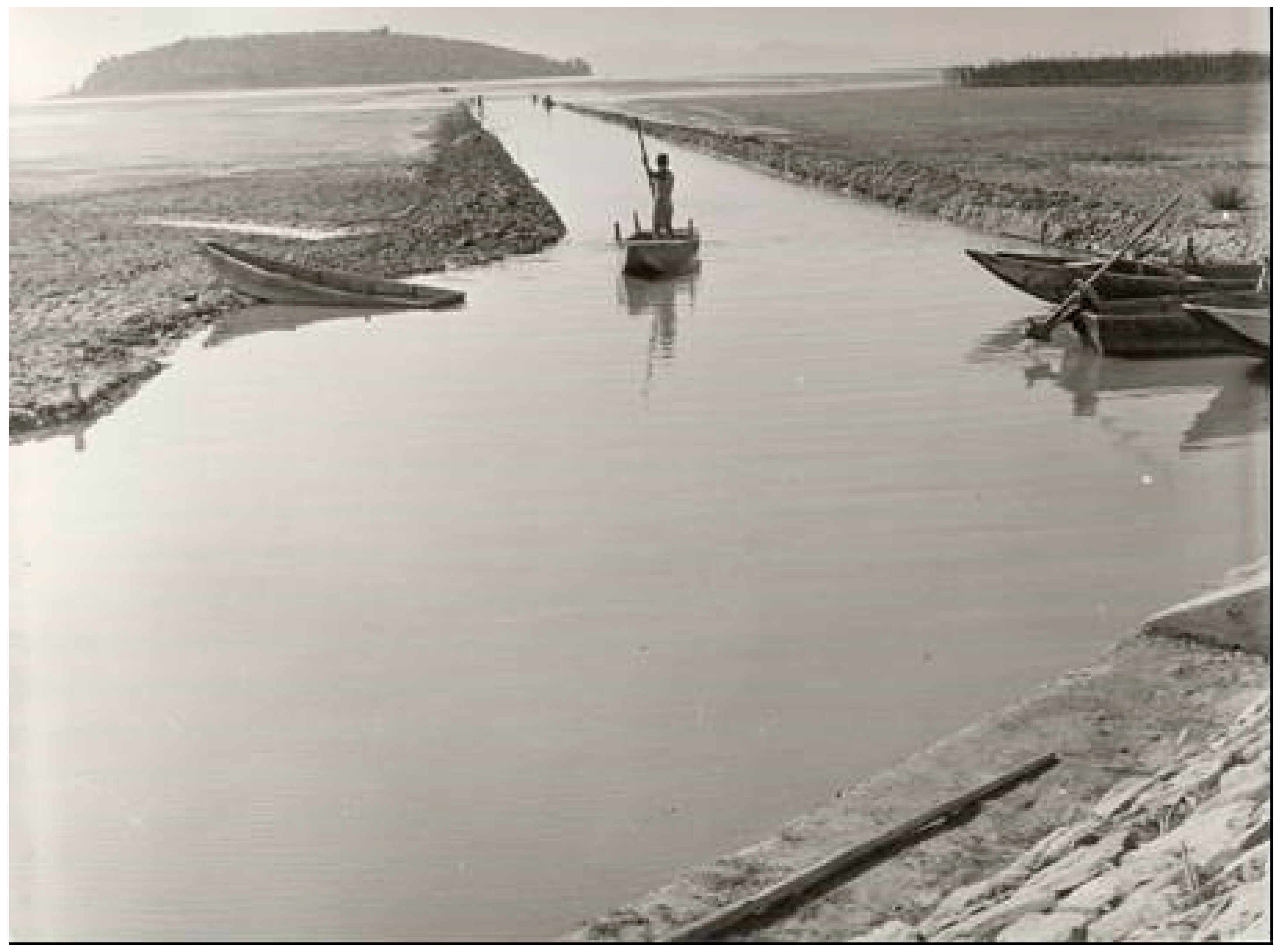
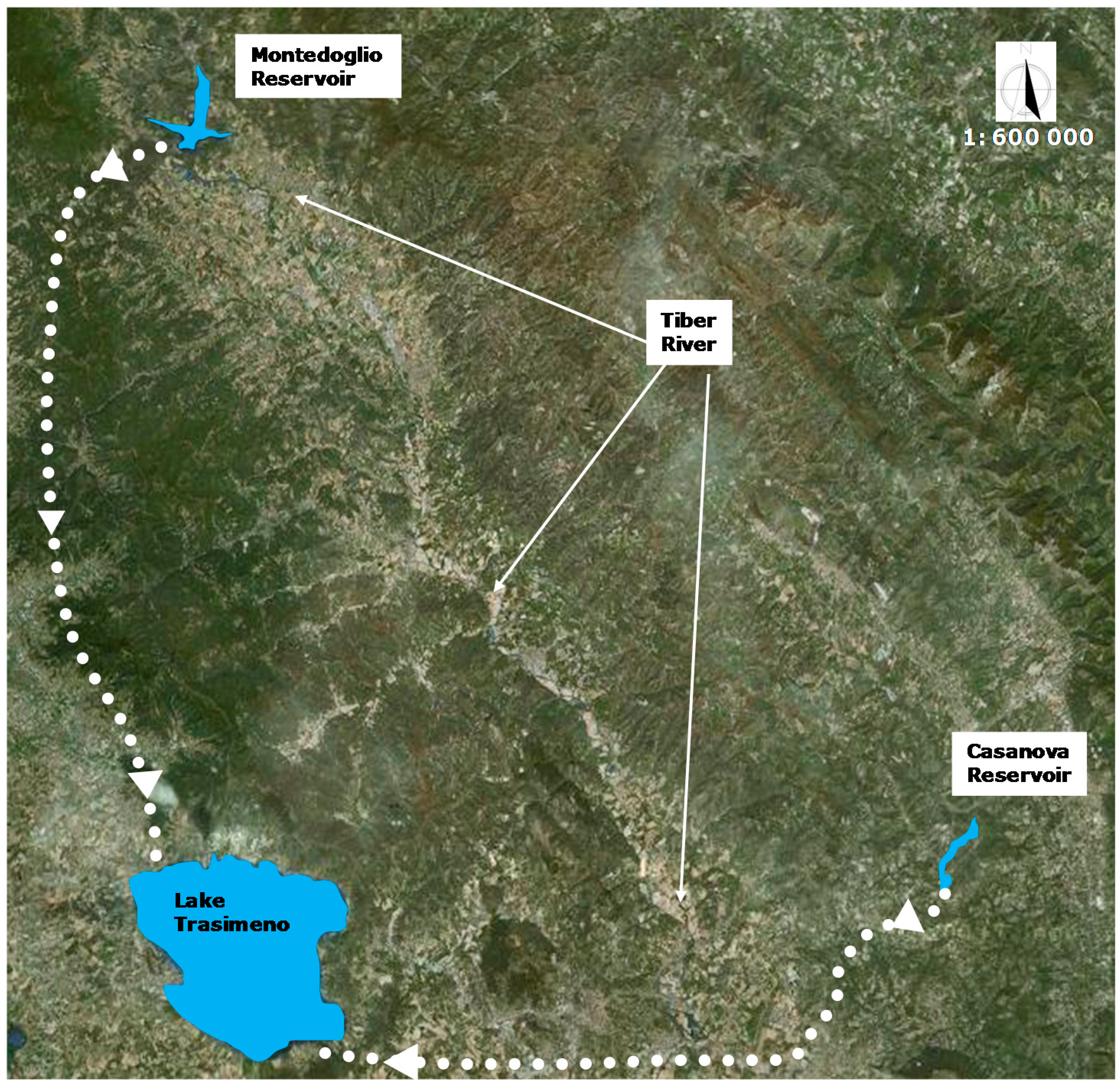
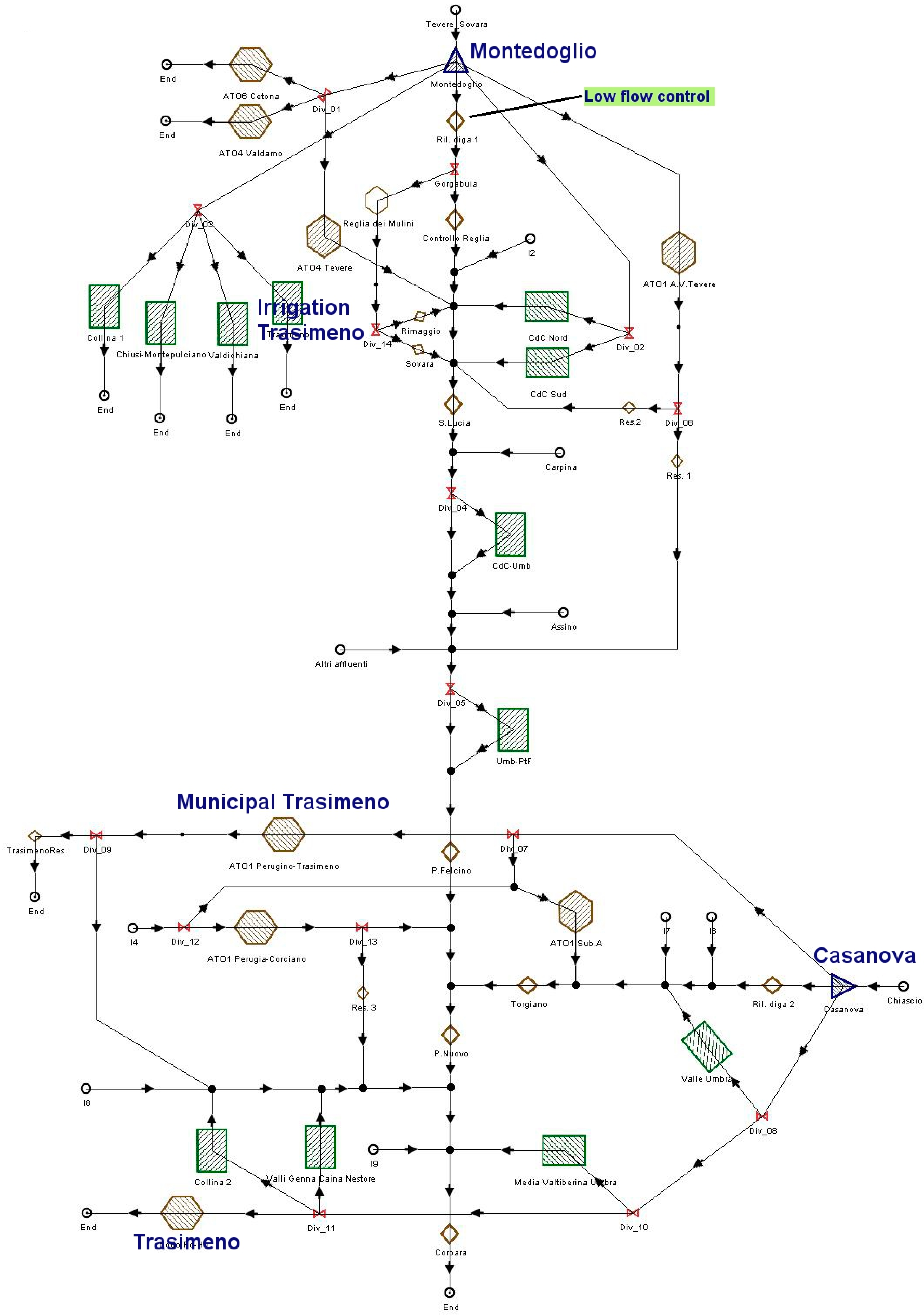


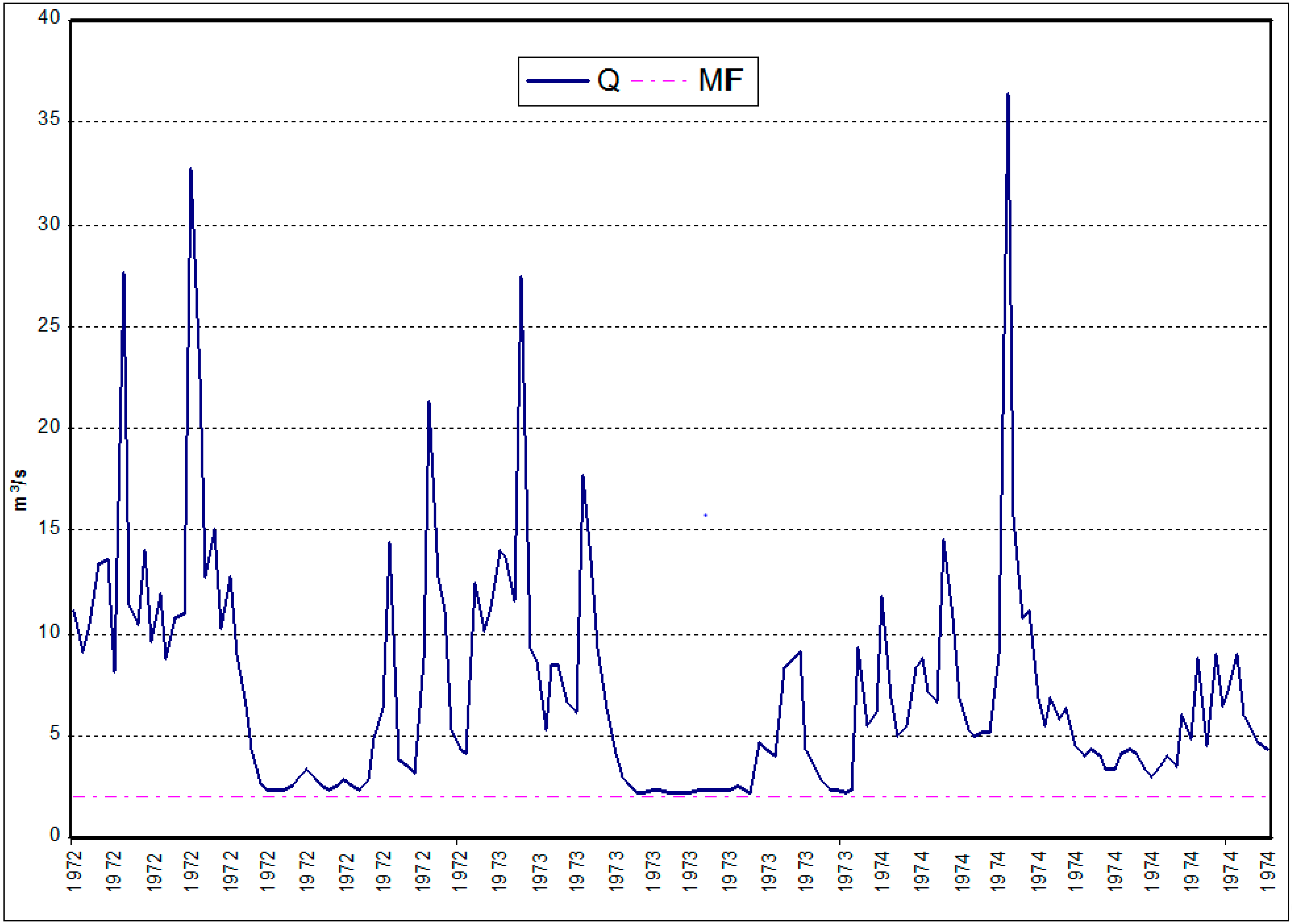
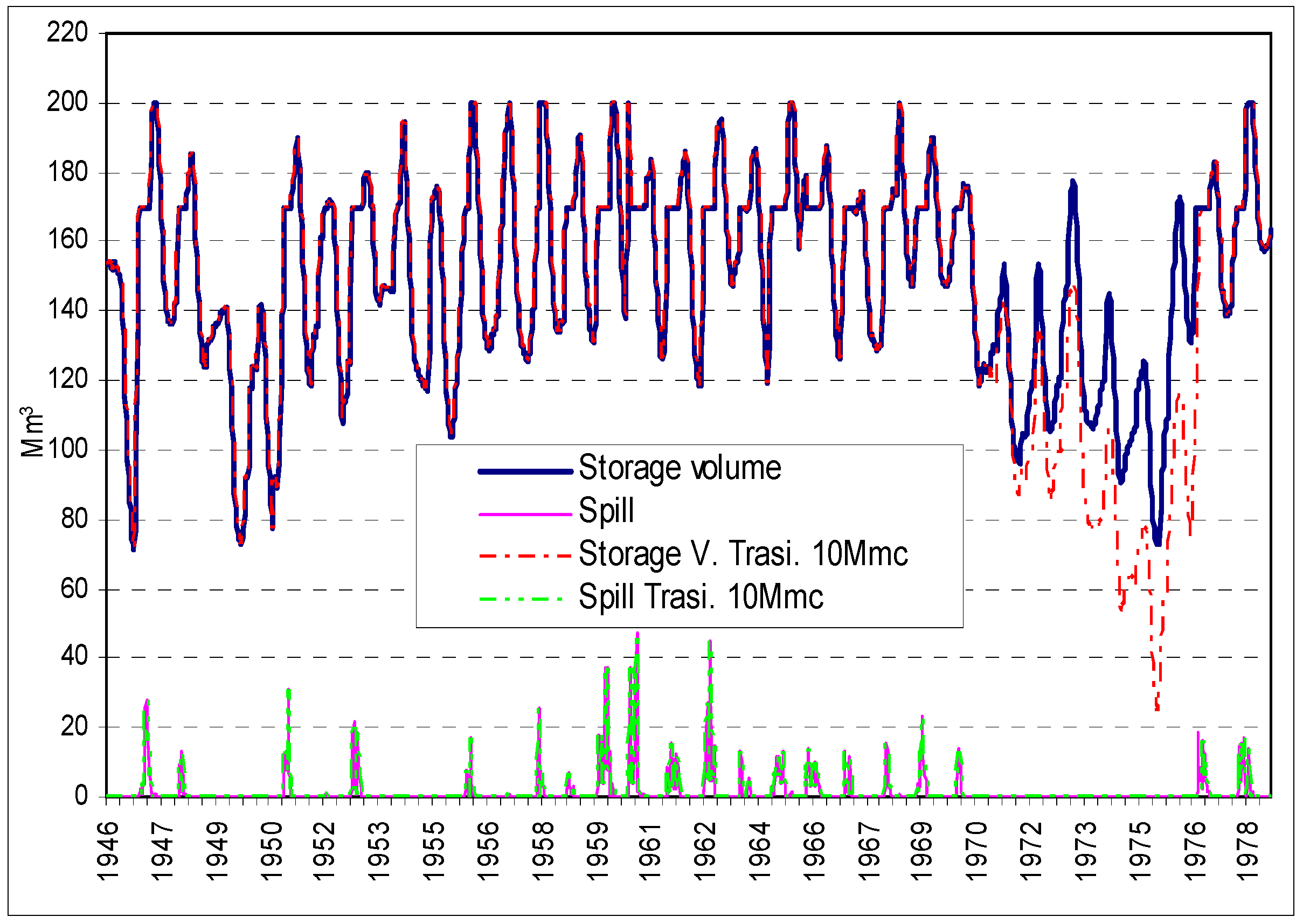
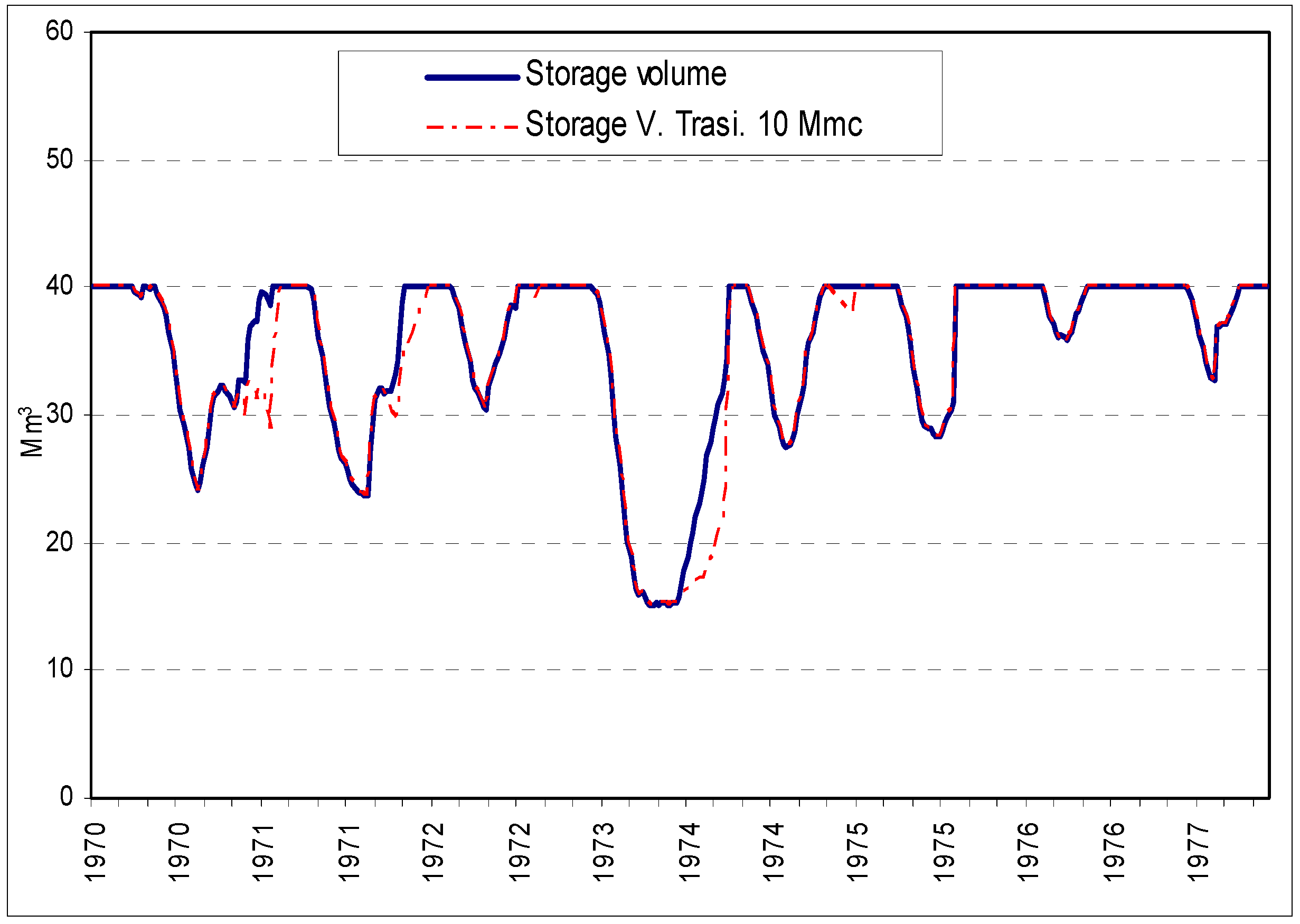
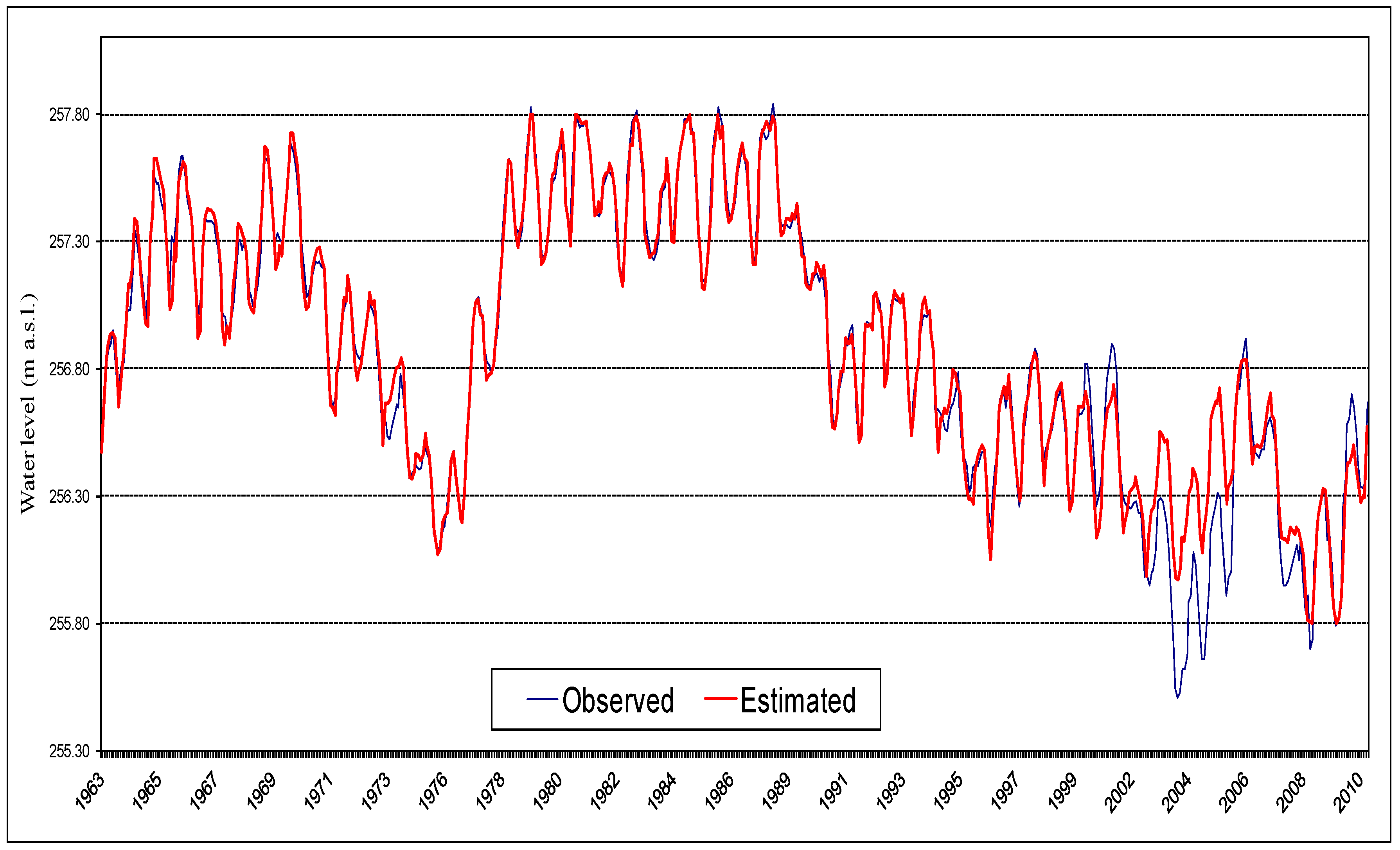
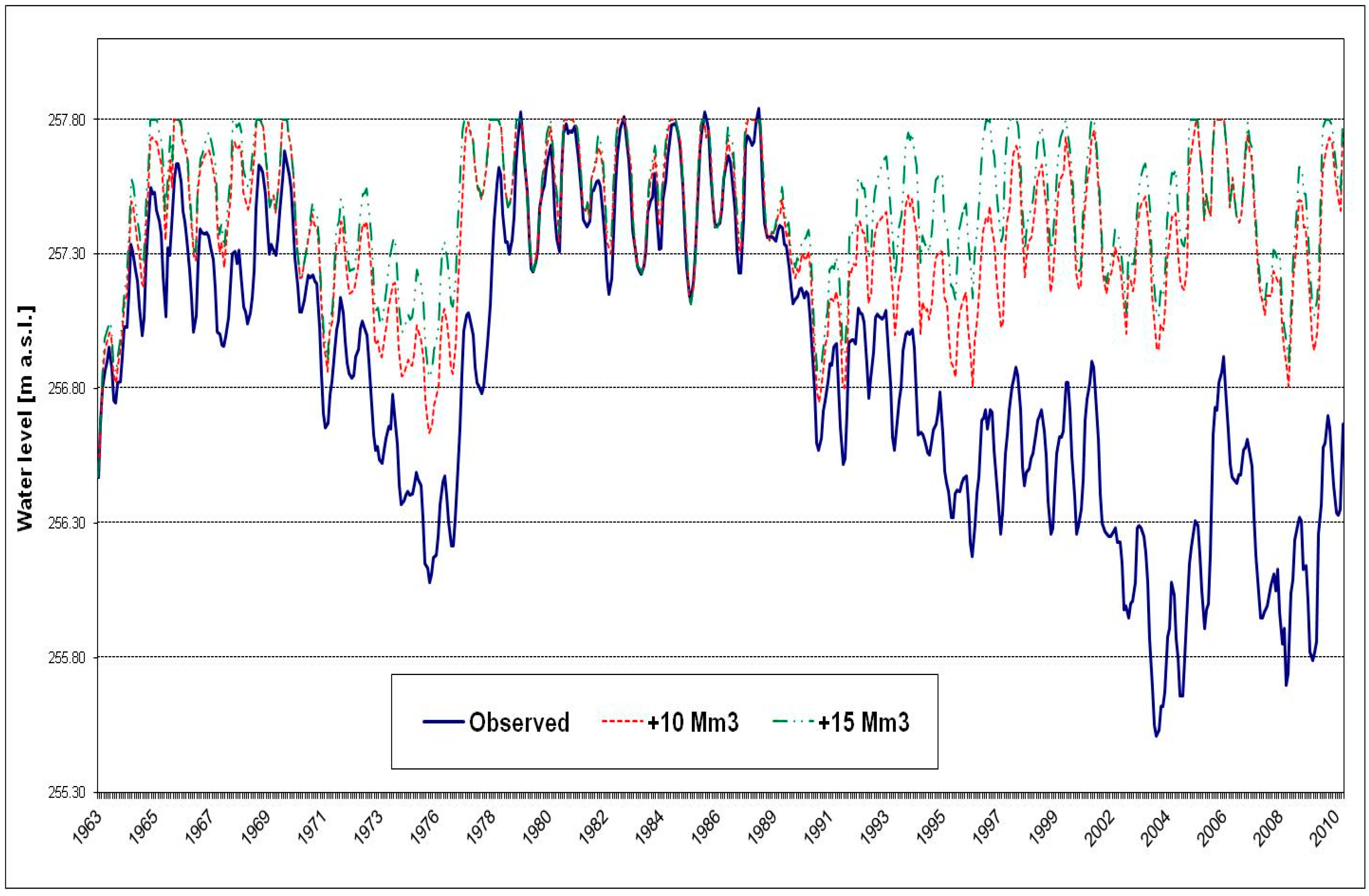
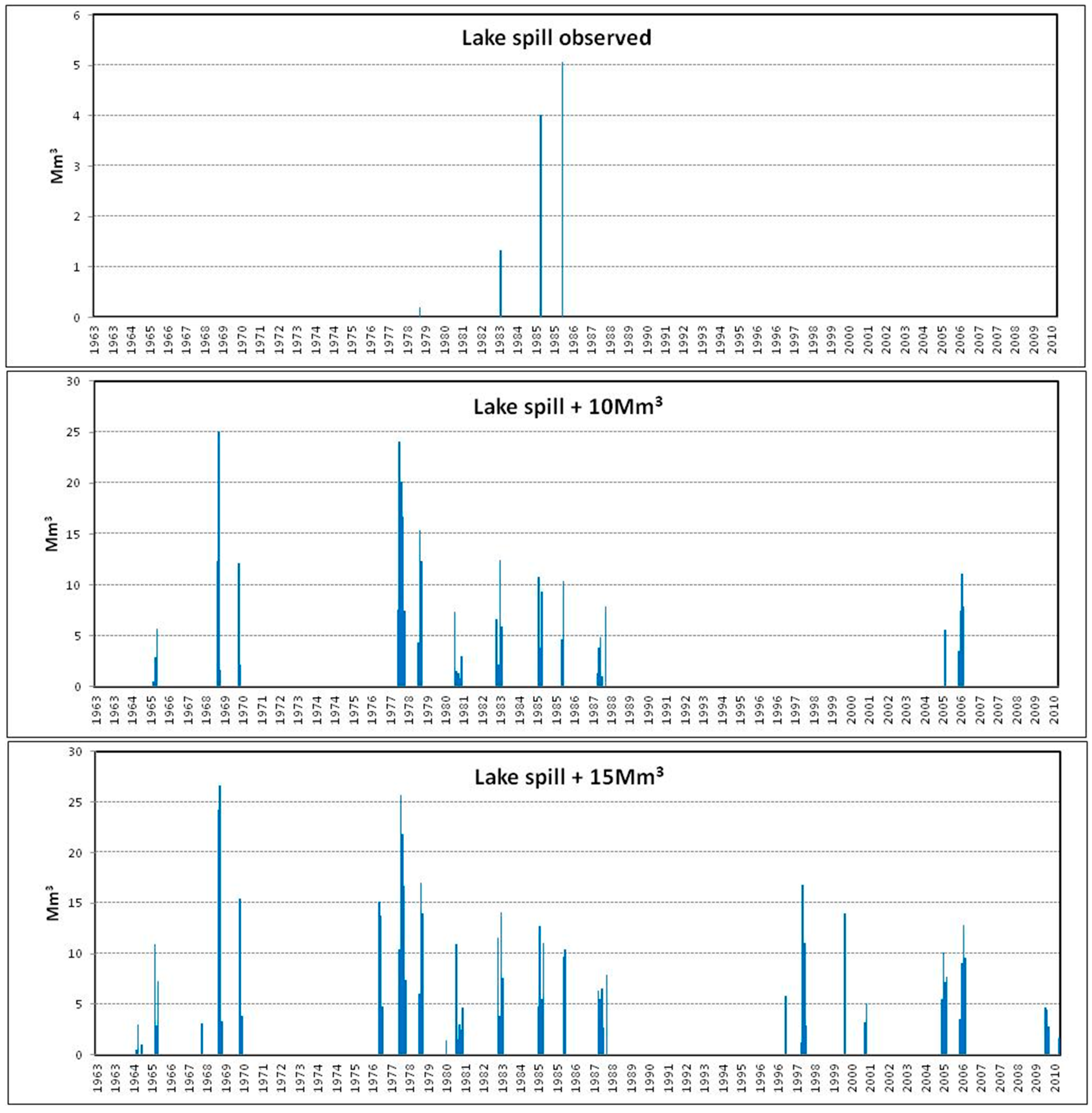


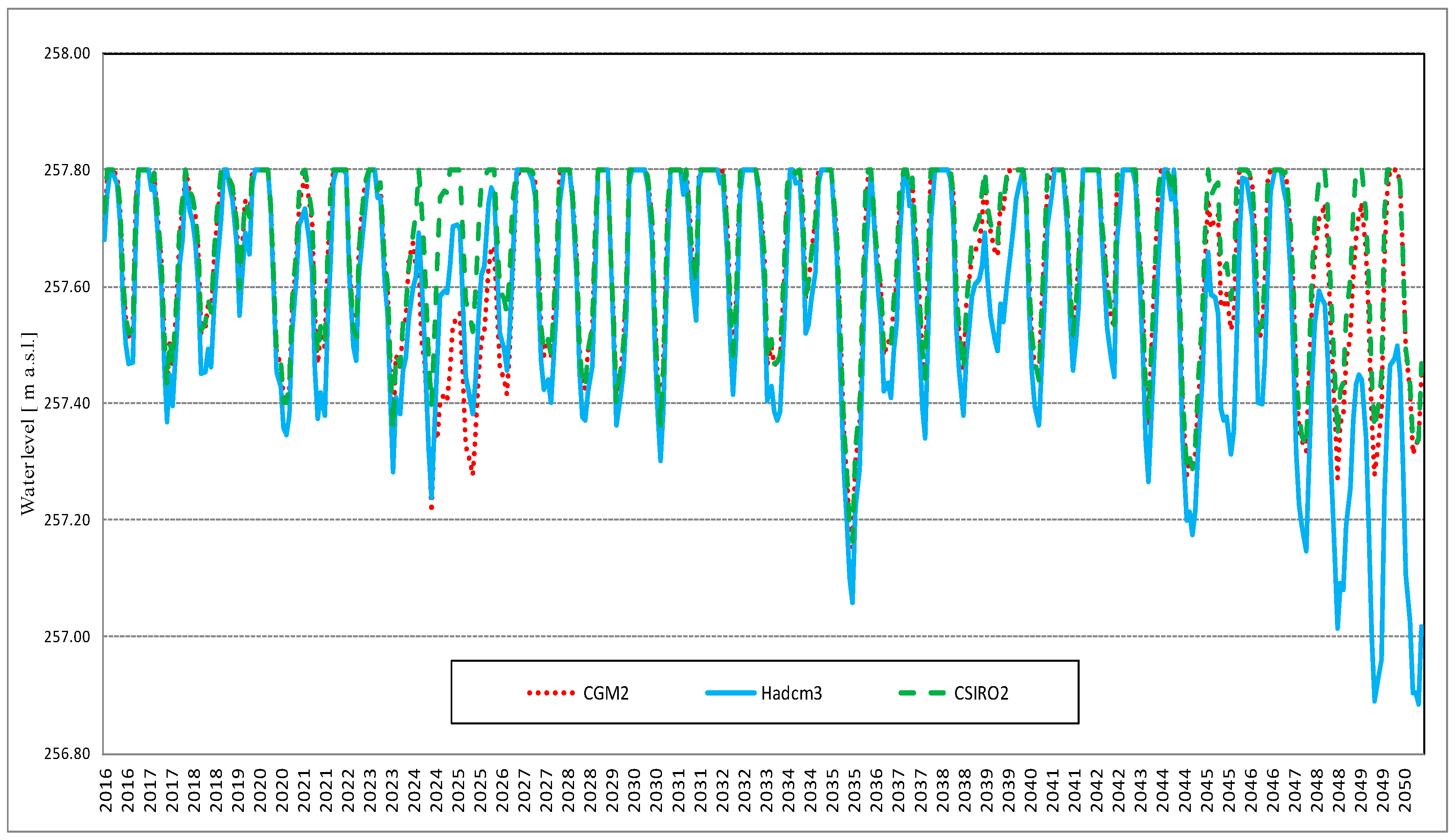
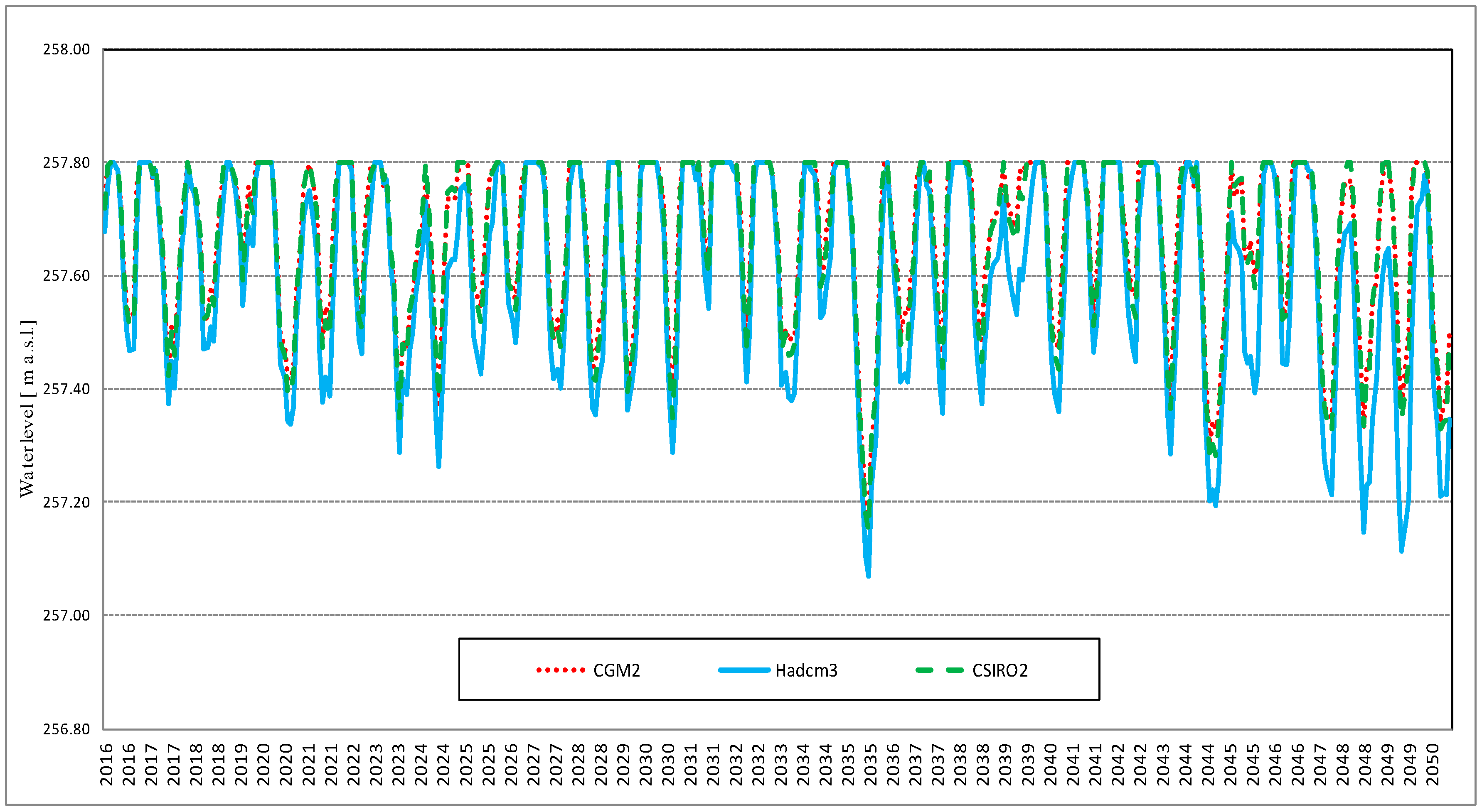
© 2016 by the authors; licensee MDPI, Basel, Switzerland. This article is an open access article distributed under the terms and conditions of the Creative Commons Attribution (CC-BY) license (http://creativecommons.org/licenses/by/4.0/).
Share and Cite
Casadei, S.; Pierleoni, A.; Bellezza, M. Integrated Water Resources Management in a Lake System: A Case Study in Central Italy. Water 2016, 8, 570. https://doi.org/10.3390/w8120570
Casadei S, Pierleoni A, Bellezza M. Integrated Water Resources Management in a Lake System: A Case Study in Central Italy. Water. 2016; 8(12):570. https://doi.org/10.3390/w8120570
Chicago/Turabian StyleCasadei, Stefano, Arnaldo Pierleoni, and Michele Bellezza. 2016. "Integrated Water Resources Management in a Lake System: A Case Study in Central Italy" Water 8, no. 12: 570. https://doi.org/10.3390/w8120570





